The Atlantic Forest, also known as Mata Atlântica, used to cover over 1 million square kilometers and extended along the Atlantic coast of Brazil for over 3000 kilometers. It contained different types of forests, such as lowland rainforests in the narrow coastal plains, dry forests in the northeastern inland, and Araucaria forests in the southern mountains of Brazil. Sadly, only about 7 percent of these ancient forests remain today, scattered like small islands in a landscape shaped by human activities.
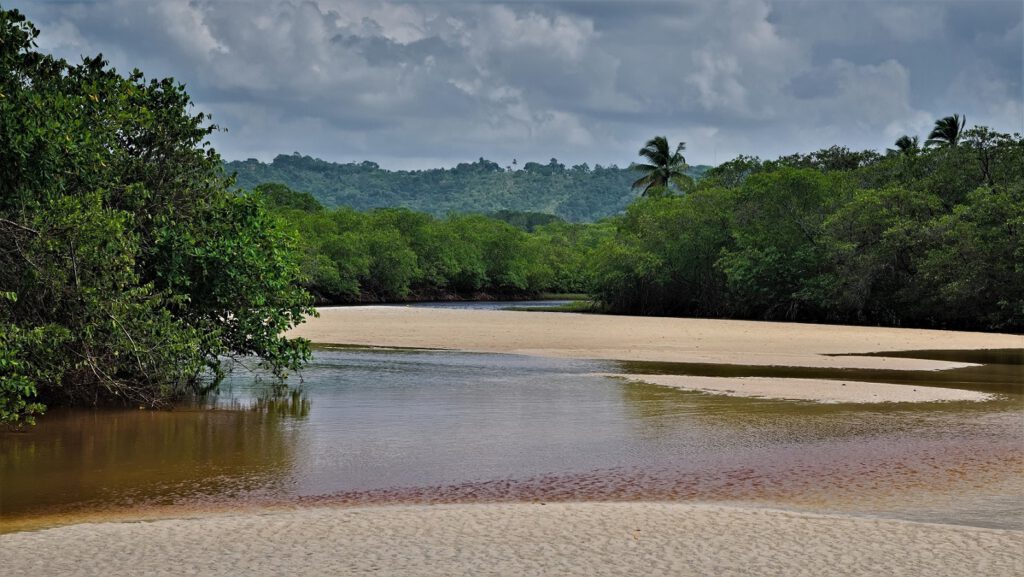
Coastal strip in the state of Bahia (Brazil), where a freshwater stream meets the saltwater of the Atlantic Ocean. The convergence of different ecosystems and environmental conditions allows for a unique diversity of animal and plant species. On the left and right, you can see mangroves, and in the center, the course of the freshwater stream (AR 09/2023)
Depending on the altitude, there are different types of forests, including mangrove forests near the coast, lowland rainforests, and mountain rainforests.
The rainforests of Mata Atlântica, where habitats, rainfall, and temperatures vary greatly, are believed to have a greater diversity of animal and plant species compared to the Amazon rainforest. However, 94 percent of the coastal rainforests have been destroyed, leaving only isolated fragments. Nevertheless, there are native animal species in this region, such as sloths and lion tamarins, which can even be found on Sugarloaf Mountain, a famous peak in the bustling city of Rio de Janeiro.
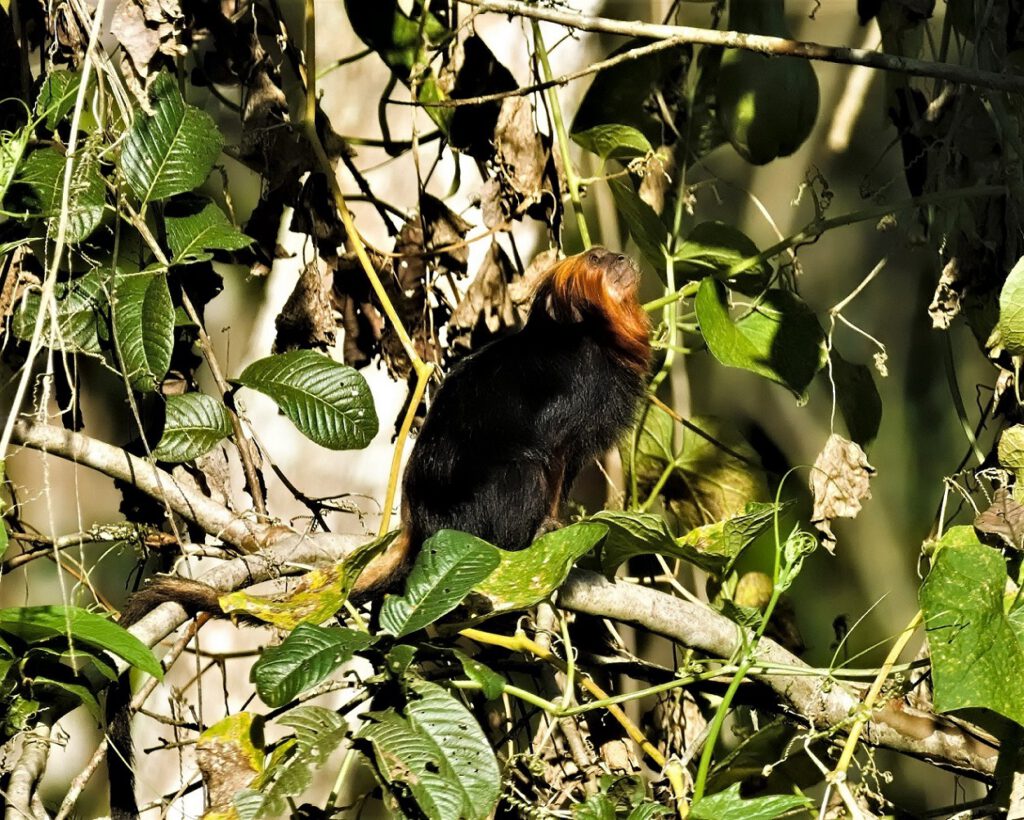
Golden-headed lion tamarins (Leontopithecus chrysomelas), also known as goldkopflöwenäffchen in German, exclusively inhabit the southeastern Brazilian rainforest known as the Mata Atlantica. Today, over 90% of their original habitat has disappeared, and their range is limited to a small area in the southern state of Bahia. In addition to habitat destruction, they continue to be threatened by illegal hunting for the pet trade (AR 09/2023)
Due to the high rainfall, especially on the mountain slopes, the vegetation is dense. Tall trees, reaching up to 60 meters, form a continuous green canopy that creates a humid and shaded microclimate. In this habitat, various plant types grow in multiple layers.
Typical and common plants in Mata Atlântica are mosses, climbing plants called „Cipós,“ bromeliads, and orchids. It is estimated that this region, including insects, is home to around 1.6 million species. At least 8,000 plant and animal species are endemic, meaning they are found only here. These endemic species include 55% of tree species, 70% of bromeliads, 64% of palms, 39% of mammals, 160 bird species, and 183 amphibians. It is likely that many species went extinct before being cataloged. Some of the threatened animal species in Mata Atlântica include sloths, howler monkeys, and lion tamarins.
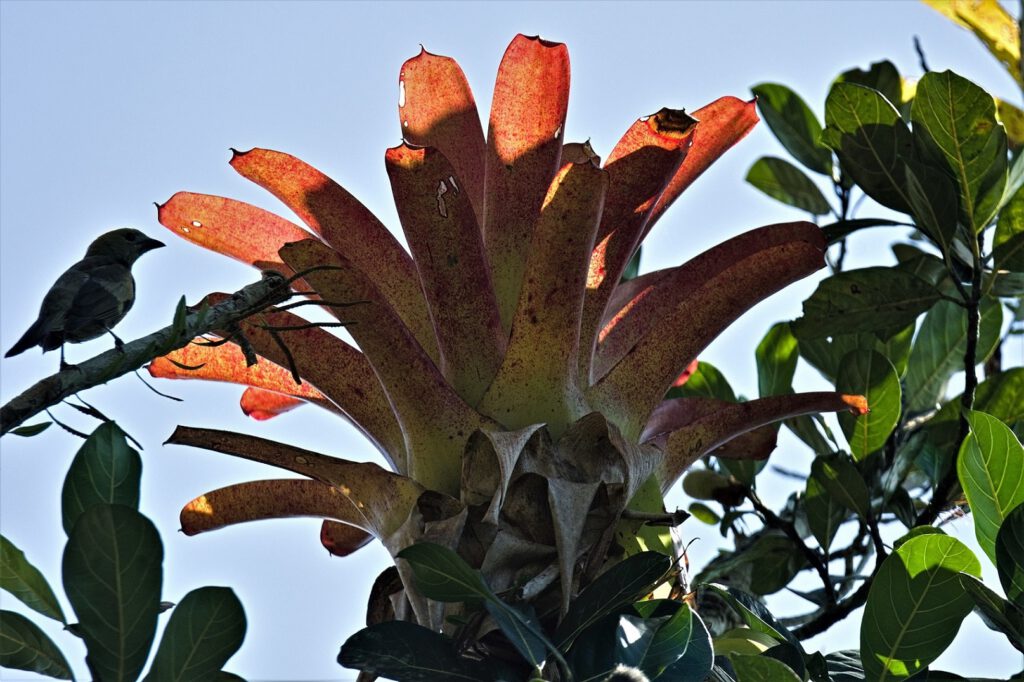
Bromeliads are plants that belong to the Bromeliaceae family (comprising over 3,000 species in about 58 genera, such as Bromelia and Ananas) and are primarily found in the tropical regions of Central and South America. A significant number of them form rosettes of leaves and store water in their leaves. Many bromeliads are epiphytic, rather than rooting in the ground; they grow on other plants and obtain their nutrients from the air and rain. In turn, they provide habitat and food for various animals and insects. Mata Atlantica, State of Bahia, Brazil (AR 10/2023)
In tropical forests, the annual cycle is usually determined by the amount of rainfall per month, rather than significant temperature fluctuations like in European summers and winters. For example, tropical cloud forests, found in the mountains, are slightly cooler and receive more rainfall compared to tropical lowland rainforests. The latter generally have consistent temperatures throughout the year. Moreover, the Amazon rainforest generates 50-80% of its own rain through evaporation.
Evergreen tropical lowland rainforests are found at elevations up to approximately 1,200 meters above sea level. They experience a perhumid climate, meaning there are no dry months, and they receive consistently high rainfall throughout the year, typically 1,600 mm or more annually. The average temperature in the coldest month remains at least 18°C, while the yearly average temperature usually stays above 24°C.
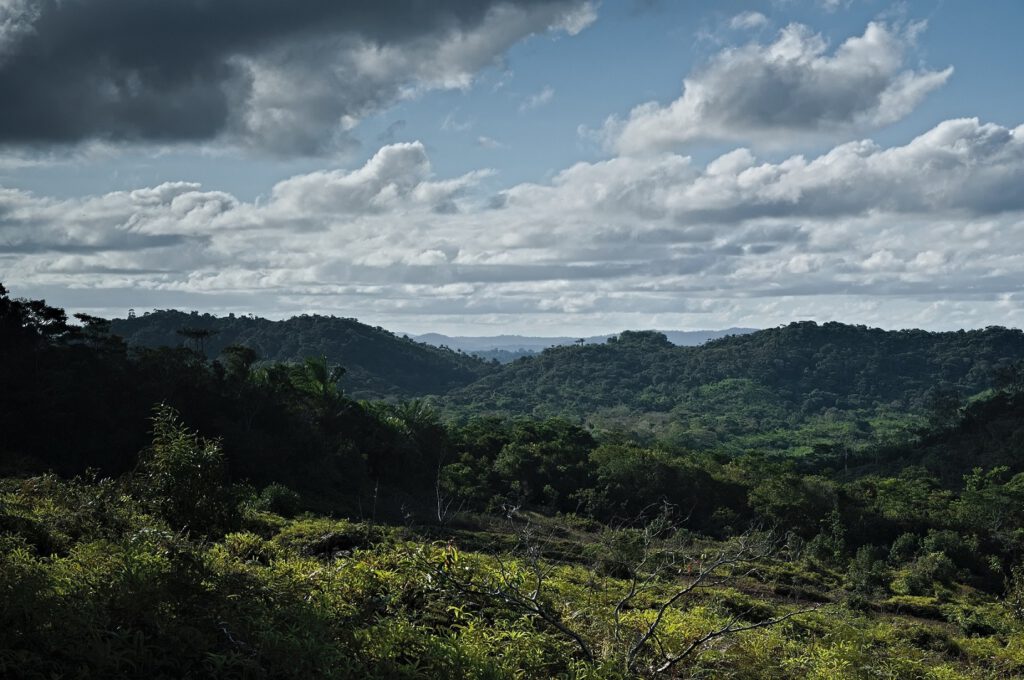
Evergreen tropical lowland rainforest (Mata Atlantica). Found at low elevations up to approximately 1,200 meters above sea level. The plants never shed their leaves all at the same time and exist in communities on different levels (in the so-called ’stratified structure‘ between the forest floor and tree canopies). State of Bahia, Brazil (AR 09/2023)
In these rainforests, the plants do not shed their leaves all at once, and they coexist in communities at different levels (in what is called the „canopy structure“ between the forest floor and the tree crowns).
Semi-evergreen tropical rainforests are often found in the transitional area between evergreen tropical rainforests and monsoon forests or dry forests. They receive a minimum of 1,200 mm of rainfall, and the dry season lasts for 3-4 months.
In these rainforests, the plant life also does not shed its leaves all at once, and the forest consists of dense, tall areas, with individual trees growing up to 45 meters in height. Large woody climbing plants are also very common in this type of forest.
Tropical dry forests are found in tropical regions where rainfall varies significantly throughout the year, and dry periods can last 5-8 months.
The plants in these forests are adapted to the long dry seasons and have developed water-storing tissues in their stems or leaves. Many tree species shed their leaves during the dry season and regrow them at the beginning of the rainy season. The longer the dry periods last, the more challenging it becomes for the trees to grow. As a result, the dry forests become sparser and gradually transition into savannas, which are dominated by short-period grasses.
Tropical montane cloud forests are found at elevations ranging from 1,200 meters to 3,900 meters.
In these forests, parts of the trees are covered with mosses and small ferns. Tall emergent trees, which tower above the canopy, and stilt roots are rare because they struggle to find support in the steep slopes of the higher tropical mountain rainforests.
Starting at around 1,200 meters above sea level, the lowland rainforests gradually transition into mountain rainforests. As the average temperature falls below 18 degrees Celsius, many tree species from the lowlands are replaced by species adapted to life in mountain regions. The impressive multi-layered trees of the lowland rainforests gradually give way to shorter trees. The trunks and branches become knottier, the tree crowns more compact, and the leaves smaller, thicker, and harder. Woody climbers like lianas disappear, while epiphytes such as orchids, ferns, bromeliads, and mosses become more numerous with increasing altitude.
Here’s an attempt to categorize tropical mountain rainforests based on elevations, with noticeable moss coverage increasing at higher elevations:
Lower mountain rainforests are found at elevations of approximately 1,200 meters; tree heights range from 15 to 35 meters; the vegetation consists of two to three layers; abundant growth of epiphytes; clouds start to form, and about 10% of the tree trunks are covered with moss.
Upper mountain rainforests are found at elevations of around 2,000 meters; tree heights range from 2 to 20 meters; heavy cloud formation; divided into lower mountain cloud forests with 25 to 50% of tree trunks covered in moss and upper mountain cloud forests with 70 to 80% of tree trunks covered in moss.
Subalpine cloud forests are found at elevations of approximately 2,800 meters; due to the high altitude, the average temperature is less than 10°C; trees grow extremely low; few epiphytes are present; there is a lot of fog and clouds, resulting in abundant moss coverage on the tree trunks.
Indeed, tropical mountain rainforests are highly diverse and are considered hotspots of biodiversity. They usually receive higher rainfall compared to lowland rainforests. These mountain rainforests are primarily found in Central and South America and Southeast Asia. The eastern Andean region, in particular, is one of the most important hotspots of biodiversity. There are also isolated mountain rainforests in Africa. The unique combination of elevation, temperature, and humidity in these regions creates ideal conditions for a wide variety of plant and animal species to thrive, making them crucial areas for conservation efforts.
Mangrove forests are found along the soft, muddy coasts of tropical regions and experience daily flooding due to the tides.
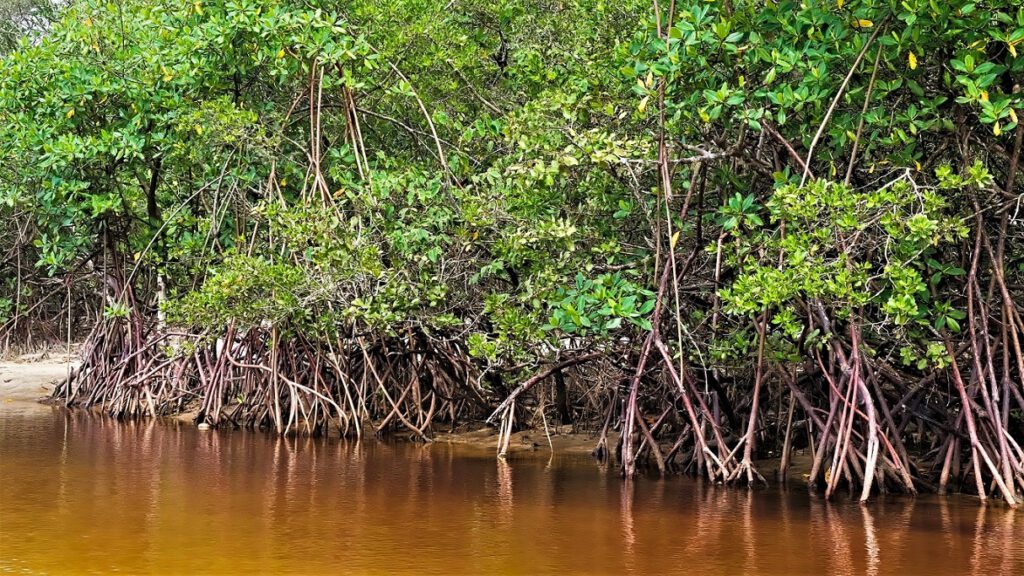
One of their remarkable features is the striking prop roots (also known as stilt roots) that originate from the lower part of the tree trunk. The seeds of mangroves germinate while still attached to the parent plant. While mangrove forests may have fewer plant species compared to other types of forests, they play a crucial role as nurseries for many marine animals.
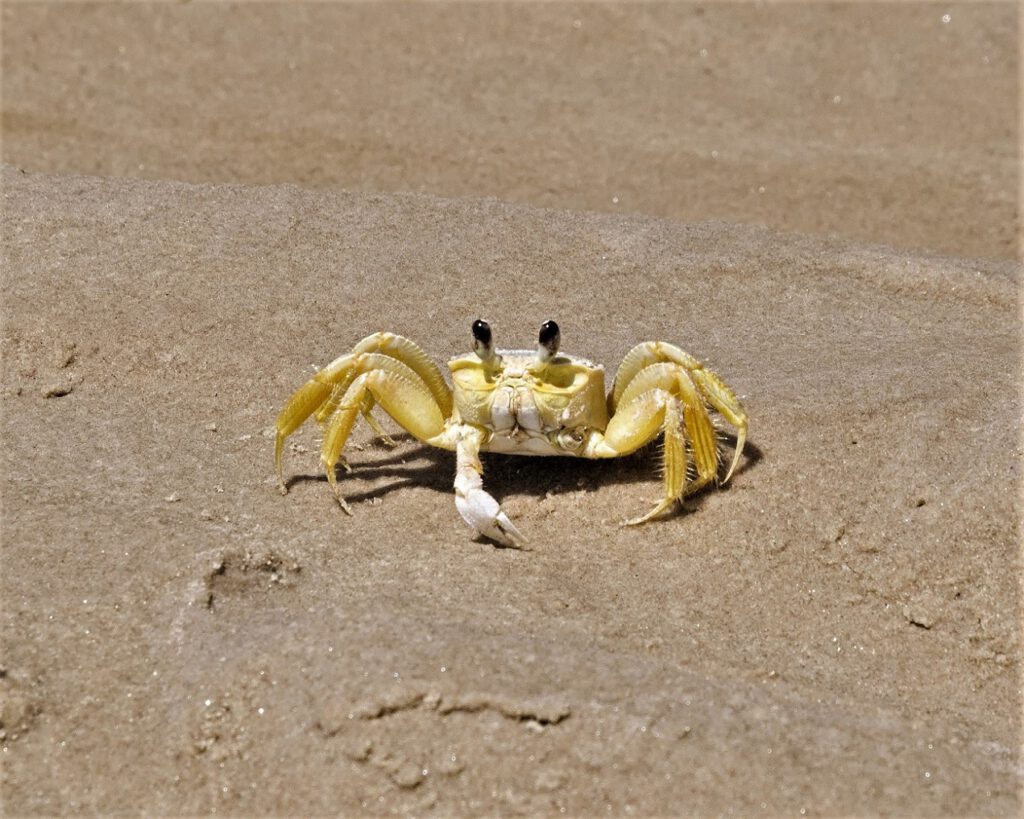
The Atlantic Ghost Crab (Ocypode quadrata), also known as the Fiddler Crab, is comfortable in the vicinity of mangroves (AR 09/2023)
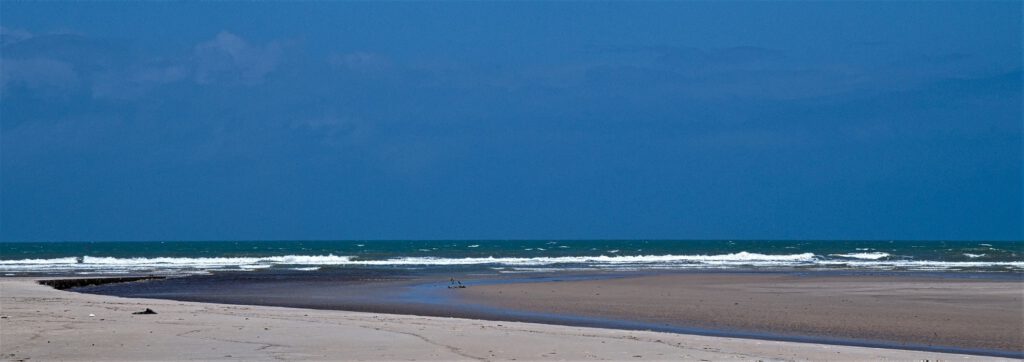
Coastal strip in the state of Bahia (Brazil), where a freshwater stream meets the saltwater of the Atlantic Ocean (AR 09/2023)